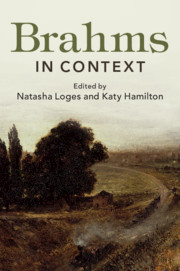Book contents
- Brahms in Context
- Brahms in Context
- Copyright page
- Dedication
- Contents
- Illustrations
- Music Examples
- Notes on Contributors
- Preface
- Abbreviations
- Part I Personality, People and Places
- Part II Identities, Environments and Influences
- Part III Performance and Publishing
- Part IV Society and Culture
- Part V Reception and Legacy
- Chapter 31 Germany
- Chapter 32 England
- Chapter 33 Analysis
- Chapter 34 The Era of National Socialism
- Chapter 35 Editing Brahms
- Chapter 36 Recordings
- Chapter 37 Historical Performance
- Chapter 38 Inspiration
- Chapter 39 Mythmaking
- Further Reading
- Index
- References
Chapter 38 - Inspiration
from Part V - Reception and Legacy
Published online by Cambridge University Press: 15 May 2019
- Brahms in Context
- Brahms in Context
- Copyright page
- Dedication
- Contents
- Illustrations
- Music Examples
- Notes on Contributors
- Preface
- Abbreviations
- Part I Personality, People and Places
- Part II Identities, Environments and Influences
- Part III Performance and Publishing
- Part IV Society and Culture
- Part V Reception and Legacy
- Chapter 31 Germany
- Chapter 32 England
- Chapter 33 Analysis
- Chapter 34 The Era of National Socialism
- Chapter 35 Editing Brahms
- Chapter 36 Recordings
- Chapter 37 Historical Performance
- Chapter 38 Inspiration
- Chapter 39 Mythmaking
- Further Reading
- Index
- References
Summary
Brahms as a point of reference for contemporary music is somewhat overshadowed by other composers. While, for example, Johann Sebastian Bach’s music is a constant subject of adaptation as well as an inspiration on different compositional levels, contemporary composers seem to be less inclined to approach Brahms’s music in this way. Whereas a composer like Helmut Lachenmann published a third voice to one of Bach’s two-part inventions and grappled with Mozart’s Clarinet Concerto K622 in his own Accanto (1975–6), he left Brahms’s music almost untouched. Even where the instrumentation suggests Brahmsian models, as in his Allegro sostenuto for clarinet, cello and piano (1986–8), a specific relationship cannot be identified. And while Brian Ferneyhough refers to Elizabethan consort music in some of his string quartets, he apparently does not consider Brahms’s contributions to this genre, such as his String Quartets Op. 51 and Op. 67.
- Type
- Chapter
- Information
- Brahms in Context , pp. 376 - 383Publisher: Cambridge University PressPrint publication year: 2019

